
The Kennedy Farm is a National Historic Landmark property on Chestnut Grove Road in rural southern Washington County, Maryland. It is notable as the place where the radical abolitionist John Brown planned and began his raid on Harpers Ferry, Virginia, in 1859. Also known as the John Brown Raid Headquarters and Kennedy Farmhouse, the log, stone, and brick building has been restored to its appearance at the time of the raid. The farm is now owned by a preservation nonprofit.
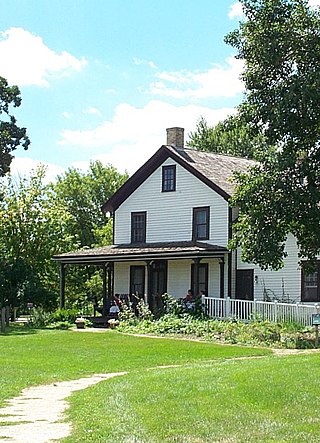
The Gibbs Farm is a museum in Falcon Heights, Minnesota, United States. The site was once the farmstead of Heman Gibbs and Jane DeBow, first built in 1854; the existing farmhouse includes the small, original cabin. The museum seeks to educate visitors on the lives of 19th-century Minnesota pioneers and the Dakota people who lived in southern Minnesota before the arrival of Europeans.

The Hunter Hereford Ranch was first homesteaded in 1909 by James Williams in the eastern portion of Jackson Hole, in what would become Grand Teton National Park. By the 1940s it was developed as a hobby ranch by William and Eileen Hunter and their foreman John Anderson. With its rustic log buildings it was used as the shooting location for the movie The Wild Country, while one structure with a stone fireplace was used in the 1963 movie Spencer's Mountain. The ranch is located on the extreme eastern edge of Jackson Hole under Shadow Mountain. It is unusual in having some areas of sagebrush-free pasture.
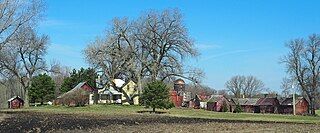
The Hagel Family Farm is a farm in Rogers, Minnesota, United States. The farm consists of a 120-acre (49 ha) parcel with several farm buildings, farm fields, woodlands, and wetlands. The farmstead has been in the Hagel family for over 150 years. Its current owner, John Hagel, is a co-founder of the Friends of Minnesota Barns association. John Hagel worked to nominate the farm to the National Register of Historic Places to preserve it as a complete, original farmstead. Susan Roth of Minnesota's State Historic Preservation Office commented, "The Hagel farm has extremely high physical integrity. I'm feeling very confident that the board will look approvingly." The farm was listed on the National Register in December 2006.

Sheldon–Owens Farm is a national historic district located at Willsboro in Essex County, New York. The district contains seven contributing buildings, one contributing site, and seven contributing structures. They are set on a property assembled between 1784 and 1945. The oldest structure is a barn dated to the late 18th century. A number of the outbuildings date to the 1830s and include barns, a granary, brick smokehouse, and sugar house. The farmhouse dates to 1853 and was constructed on the foundation of the 18th-century house. Dated to the early 20th century are a storage shed, machine shed, well house, and additions and renovations to older buildings. The property has been adapted for use as a bird sanctuary.

The Bonde Farmhouse is a historic farmhouse located in Wheeling Township in Rice County, Minnesota, United States, approximately 1 mile (1.6 km) from Nerstrand. The private home was placed on the National Register of Historic Places (NRHP) on April 6, 1982. The farmhouse is significant both for its association with a prominent Norwegian immigrant family as well as its local limestone construction and outstanding integrity.

The Houseknecht Farm is an historic house and farm which are located in Moreland Township, Lycoming County, Pennsylvania.
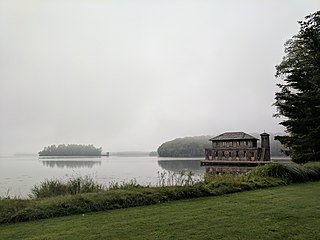
Forest Lodge is a hunting and vacation retreat of the Livingston/Griggs family on the shore of Lake Namekagon within the town of Namakagon, Wisconsin. The complex consists of 16 rustic structures built from 1893 to about 1950. Since 1999 it has been managed by the Chequamegon-Nicolet National Forest. It was added to the National Register of Historic Places in 2002.

The Norvall Hunter Farm is a historic farmstead on the edge of the village of Mechanicsburg, Ohio, United States. Established in the middle of the nineteenth century, the farm was once home to one of the village's first professionals, and it has been named a historic site because of its distinctive architecture.
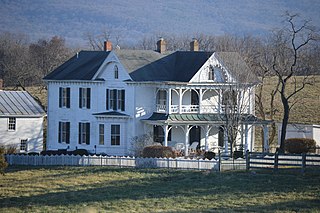
Clem–Kagey Farm, also known as the Hiram C. Clem House and Kagey House, is a historic home and farm located near Edinburg, Shenandoah County, Virginia. The farmhouse was built in 1880, and is a two-story, five bay, frame I-house dwelling with an integral rear wing. It features a full width, two-story Italianate style ornamented front porch and two brick interior chimneys. Also on the property are the contributing frame garage (c. 1920, the two-story frame wagon shed/shop building, and granary.
The John and Katharine Tunkun Podjun Farm is a farm located at 9582 East 1 Mile Road in Ellsworth, Michigan. It was listed on the National Register of Historic Places in 2002.

Lovett's by Lafayette Brook, or Lovett's Inn, is a historic farmstead and inn at 1474 Profile Road in Franconia, New Hampshire, United States. It is one of a few surviving early 20th century hostelries in the state, dating to a period when many large and more elaborate hotels stood that have succumbed to fire or demolition. It is located on the west side of Profile Road, in a rural area between the village center of Franconia and Cannon Mountain. The building was listed on the National Register of Historic Places in 1982. It continues to function as a small hotel with restaurant.

The David Hanaford Farmstead is a historic farm in Monticello Township, Minnesota, United States. It was first settled in 1855 and features a farmhouse built in 1870 and a barn from around the same time. The farmstead was listed on the National Register of Historic Places in 1979 for having local significance in the themes of agriculture and exploration/settlement. It was nominated for being "an excellent example of an early Wright County farmstead developed by a pioneer family from New England."

Kellum–Jessup–Chandler Farm is a historic home and farm located in Guilford Township, Hendricks County, Indiana. The farmhouse was built about 1862, and is a two-story, central passage plan, brick I-house with Greek Revival style design elements. It has a gable roof, two-story rear ell, and sits on a brick foundation. Also on the property are the contributing three traverse frame barns, brick smokehouse, privy, chicken house, dairy barn, milk house, corn crib, and tractor shed.

Dr. John Arnold Farm is a historic home and farm and national historic district located in Union Township, Rush County, Indiana. The farmhouse was built in 1853, and is two-story, Gothic Revival style frame dwelling. It is sheathed in clapboard and has a five-gabled roof forming a double crossed "T"-plan. It features a wraparound front porch added about 1900, and a decorative vergeboard. Also on the property are the contributing remains of an early settlement established in the 1820s, including the remains of the original John Arnold cabin, tomb, and cemetery. Other contributing buildings and structures include a smokehouse, milk house, privy, tool shed, buggy shed / garage, chicken house, granary, corn crib / shed, cattle barn, calf shed, and two additional corn cribs.
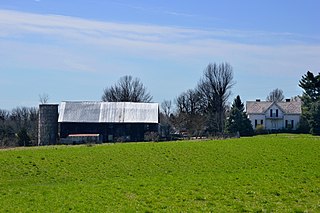
Lemuel Allen Farm is a historic home and farm located in Madison Township, Jefferson County, Indiana. The farmhouse was built in 1877, and is a 1+1⁄2-story, central passage plan, vernacular Italianate style brick dwelling. It features a side-gabled roof sheathed in slate shingles with triple-embedded and diamond patterns in red on either side of the front-gable on the façade. Also on the property are the contributing privy and large, transverse-frame basement barn, built around 1877, and a silo, the workshop, the granary, the garage, the feed shed, and a tool shed, all dated to the 1920s.

The McLemore-Sharpe Farmstead is a historic farm in Toombs County, Georgia, southwest of Vidalia. The farmstead includes two farmhouses and their associated outbuildings. The McLemore farmhouse is a log cabin, of single pen type, built in 1864, with a shed-type front porch and additional shed rooms. The Sharpe farmhouse is a one-story wood-frame house built in 1903. The property was listed on the National Register of Historic Places in 1982.

The George Louk Farm is a rural farmstead located at 1885 Tooley Road near Howell, Michigan. It was listed on the National Register of Historic Places in 1995.

The Anna and Mikko Pyhala Farm is a historic farmstead in Embarrass, Minnesota, United States, now preserved as a visitor attraction. It was established by a Finnish-American family in 1909 and includes seven surviving buildings, including several constructed with traditional Finnish log architecture, and the ruins of a prior settler's log cabin dating to around 1895. The farm was listed as a historic district on the National Register of Historic Places in 2003 for its state-level significance in the themes of agriculture, architecture, and European ethnic heritage. It was nominated for being one of St. Louis County's best examples of a Finnish-American farm with log architecture, and for its association with Finnish immigration to northeast Minnesota and the conversion of its cutover forests into productive farmland.

The William Warren Two Rivers House Site and Peter McDougall Farmstead is a historic farmstead near Royalton, Minnesota. The site was built in 1847, and was where William Whipple Warren wrote his recounting of the history of the Ojibwe people, titled History of the Ojibways based upon Traditions and Oral Statements.























